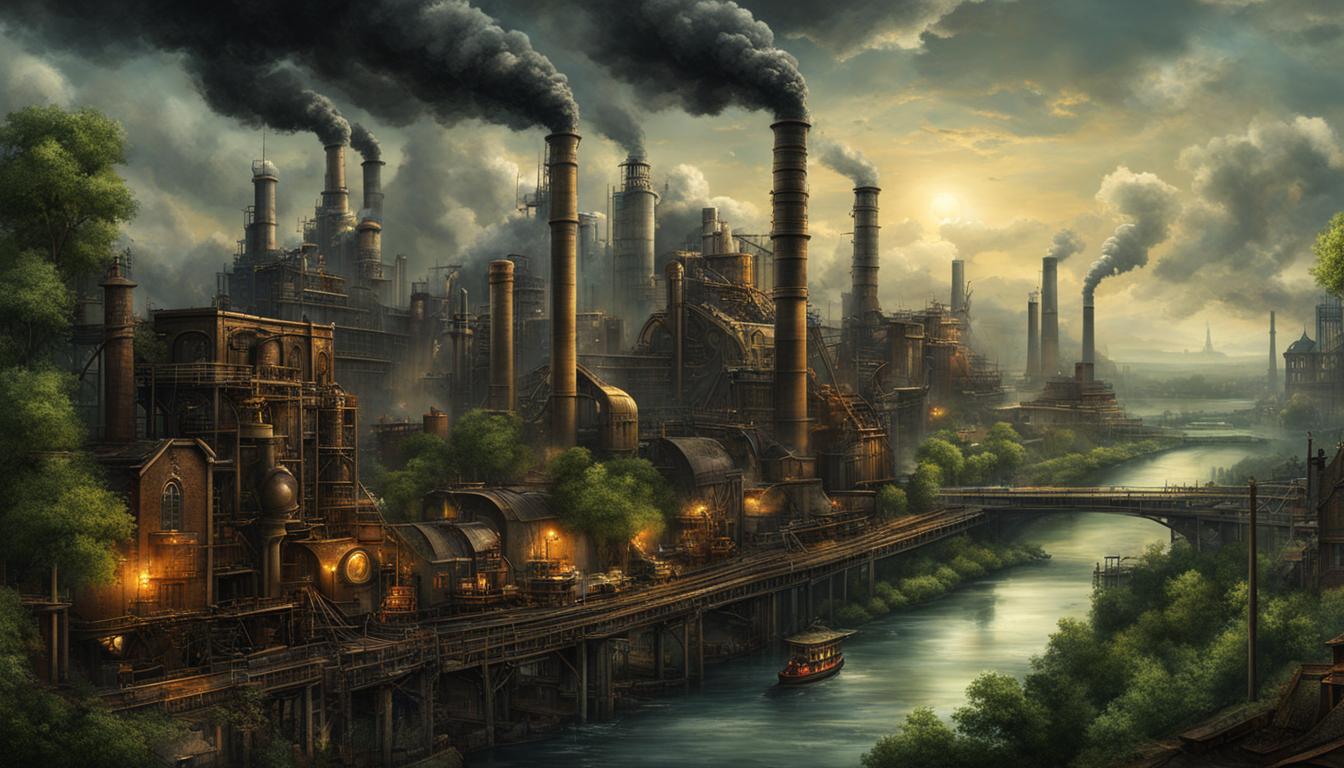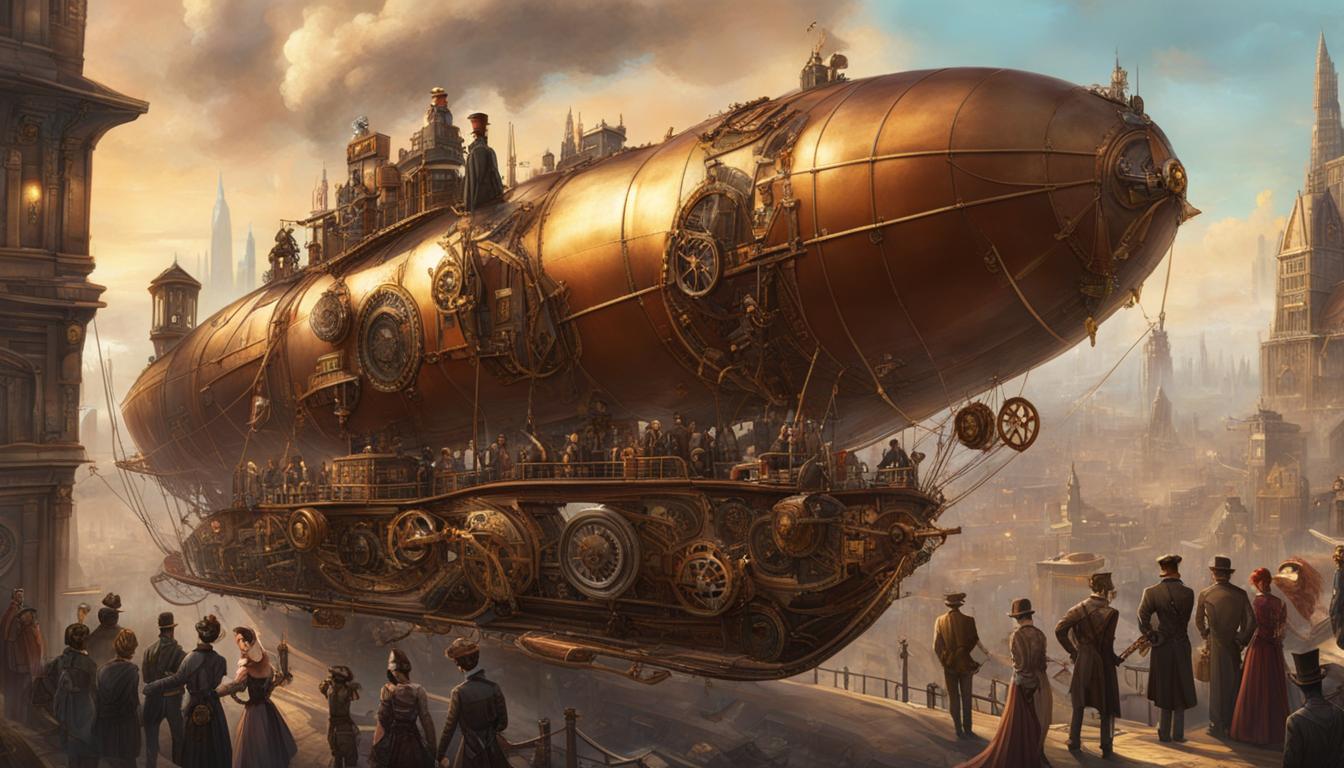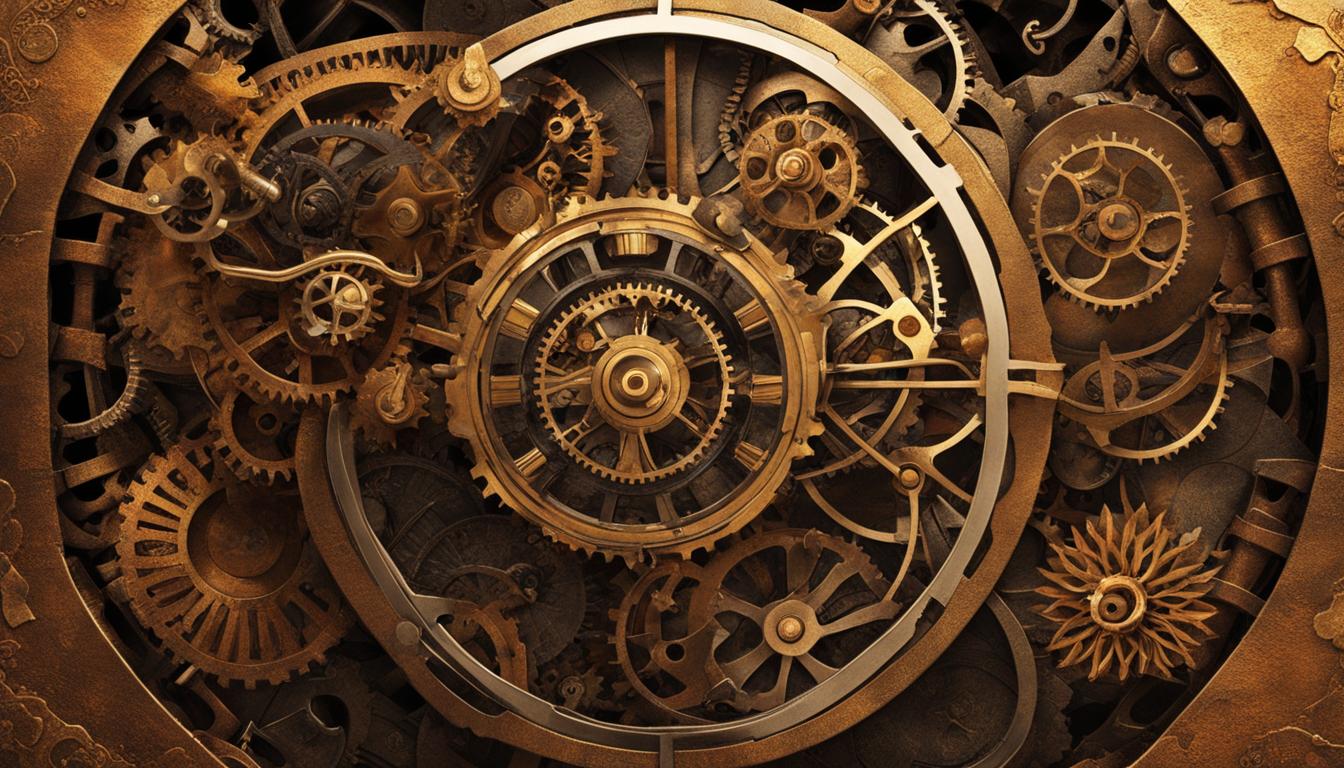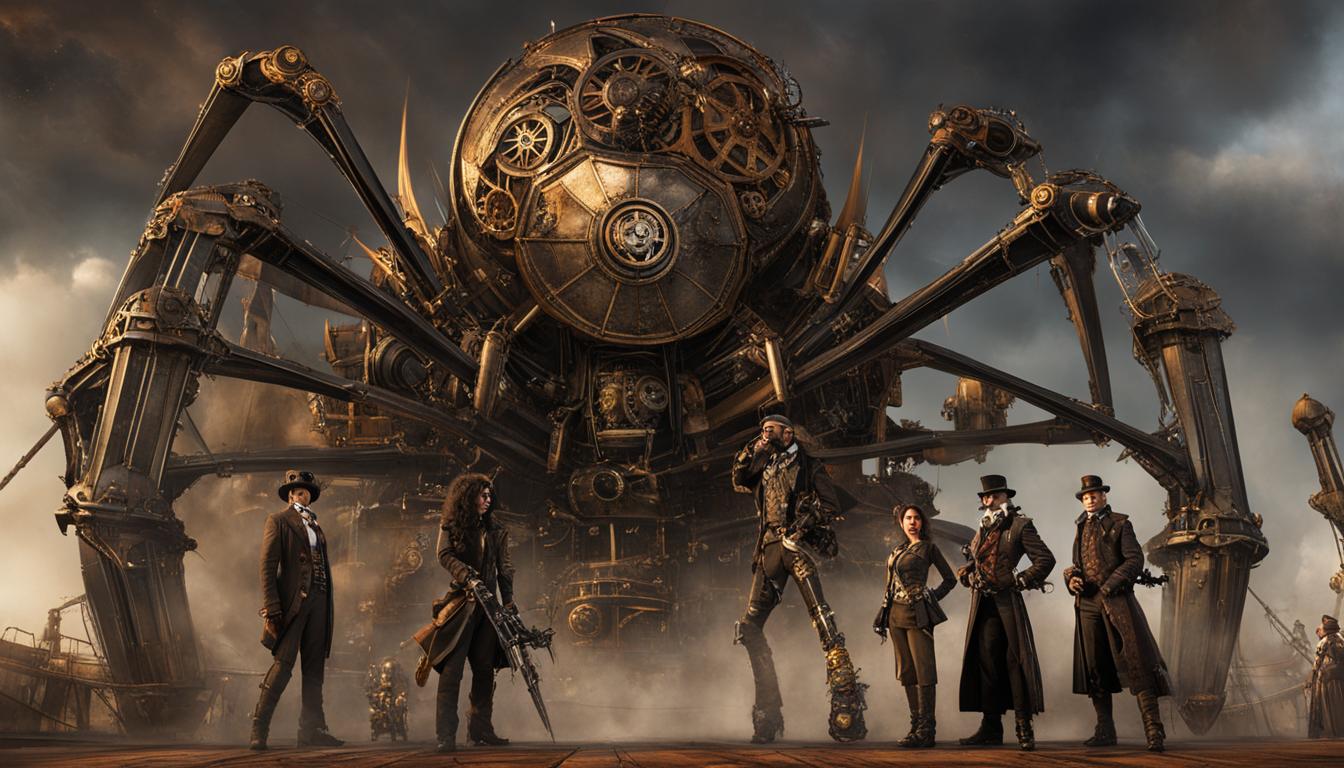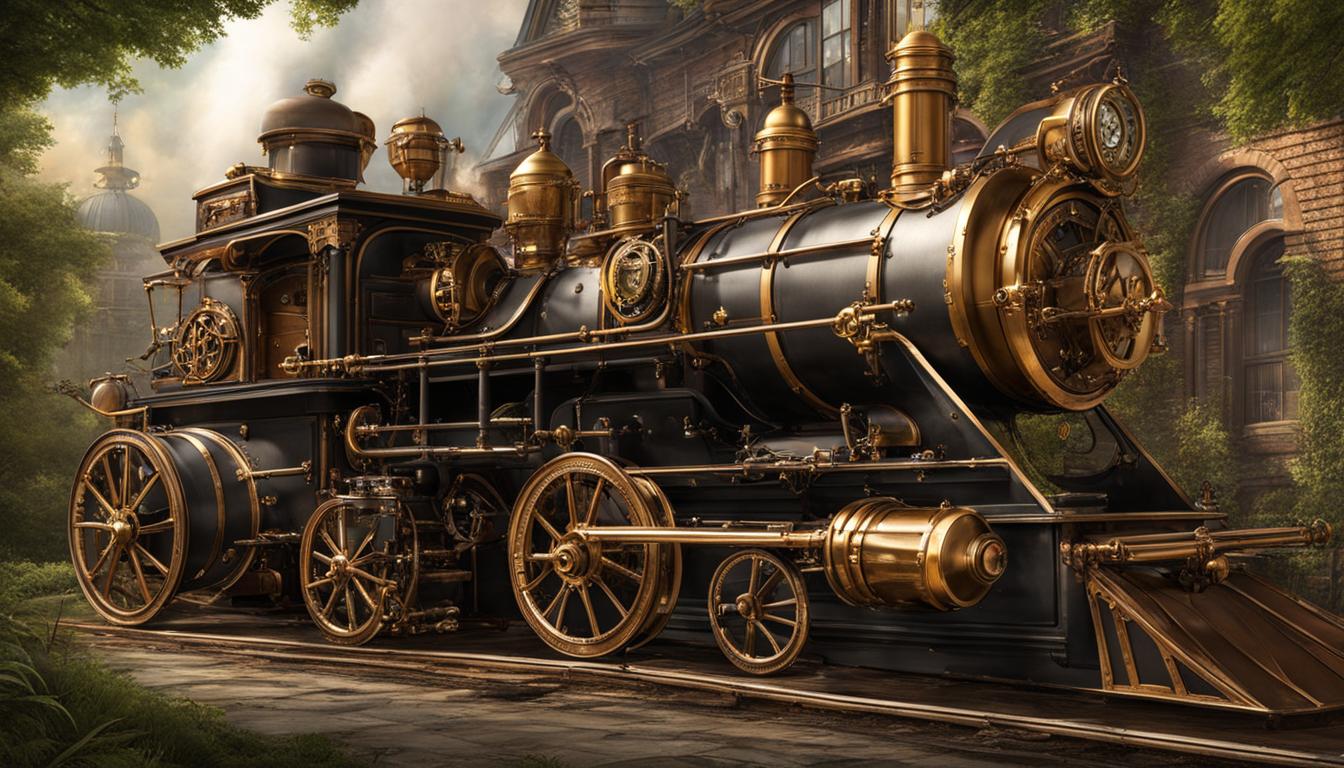Step into a world where gears whir, steam billows, and an alternate future unfolds. Steampunk, a captivating subculture, takes us back to the Industrial Revolution of Victorian-era England, but with a twist. It’s a realm that combines the elegance of the past with the imagination of science fiction, while offering a unique critique of the consequences of industrialization.
In this enchanting subculture, history is rewritten as an alternative timeline, inviting us to ponder the societal shifts caused by the Industrial Revolution. Steampunk’s creative storytelling challenges us to reflect on the past and present, shedding light on the pitfalls and triumphs of technological advancements.
Key Takeaways:
- Steampunk reimagines the Industrial Revolution through a combination of Victorian aesthetics, Wild West influences, and steam-powered science fiction.
- It critiques the consequences of industrialization by exploring an alternative future that could have resulted from this pivotal period in history.
- Steampunk’s fashion is heavily influenced by the Victorian era, showcasing a romanticized blend of sophistication and visible machinery.
- DIY is key in the steampunk subculture, valuing personalized creations and craftsmanship as a rejection of modern technology’s uniformity.
- Steampunk’s cultural movement extends beyond visual aesthetics and fashion to include literature, music, and conventions.
The Origins and Development of Steampunk
Steampunk, a subgenre of science fiction literature, emerged in the 1900s as a retrofuture concept that reimagined the Industrial Revolution. It draws inspiration from clockwork mechanisms and nineteenth-century machinery, crafting an alternative future where steam power remains dominant. Unlike its cyberpunk counterpart, steampunk embraces the elegance of the Victorian era, incorporating open-faced clockwork and intricate designs into its aesthetic. This subculture has garnered a global following, attracting participants from diverse backgrounds and age groups.
The essence of steampunk lies in its fascination with the past, specifically the Victorian era and the Industrial Revolution. It envisions a world where steam-powered technology evolved without being overshadowed by petroleum energy. Clockwork mechanisms and elaborate contraptions define the retrofuturistic style that distinguishes steampunk from other genres. The visual appeal of steampunk can be attributed to its focus on intricate details and mechanical intricacies, evoking a sense of wonder and nostalgia.
Steampunk has evolved beyond literature, permeating various forms of media and creative expression. It has influenced fashion, music, art, and even film. The fusion of Victorian aesthetics with technological innovation has led to a distinctive visual style in steampunk fashion. The use of corsets, top hats, goggles, and gears in clothing and accessories exemplify the subculture’s commitment to blending past and future. Steampunk bands offer a sonic experience that complements the overall atmosphere, further enhancing the immersive nature of the subculture.
| Steampunk Origins | Retrofuture Concept |
|---|---|
| Emerges as a subgenre of science fiction literature | Reimagines a world where steam power remains dominant |
| Inspired by clockwork mechanisms and nineteenth-century machinery | Showcases intricate designs and open-faced clockwork |
| Contrasts cyberpunk genre | Embraces the elegance of the Victorian era |
The origins and development of steampunk have fostered a vibrant and diverse community of enthusiasts and creatives. Through its imaginative storytelling and unique aesthetic, steampunk continues to captivate and inspire, offering a nostalgic journey into an alternative future where the power of steam reigns supreme.
The Steampunk Aesthetic and Fashion
Steampunk fashion captures the essence of the Victorian era with its sophisticated and elegant style. It is characterized by a fusion of vintage Victorian clothing and futuristic elements inspired by steam-powered machinery and technology. The subculture embraces a romanticized vision of the past while incorporating imaginative and creative designs.
The key elements of steampunk fashion include the use of rich colors such as jewel tones, black, brown, and metallic accents like copper and brass. Accessories, such as goggles, top hats, corsets, and pocket watches, are essential in completing the steampunk look. One distinctive feature is the incorporation of open-faced clockwork, where the intricate mechanisms of steam-powered machinery are exposed, adding a touch of mystery and intrigue.
Inspired by the concept of automata, steampunk fashion often combines machinery with clothing, blurring the line between man and machine. Victorian-style dresses and suits are adorned with gears, cogs, and other mechanical embellishments, creating a sense of fusion between technology and humanity.
Distinguishing Features of Steampunk Fashion
- Victorian-inspired clothing with a futuristic twist
- Rich colors and metallic accents
- Visible machinery and open-faced clockwork
- Incorporation of gears, cogs, and other mechanical embellishments
- Mixed gender fashion with corsets and tailored suits
Steampunk fashion is a celebration of imagination, creativity, and individuality. It offers an escape from the monotony of modern fashion, allowing individuals to express their own unique style and personality.
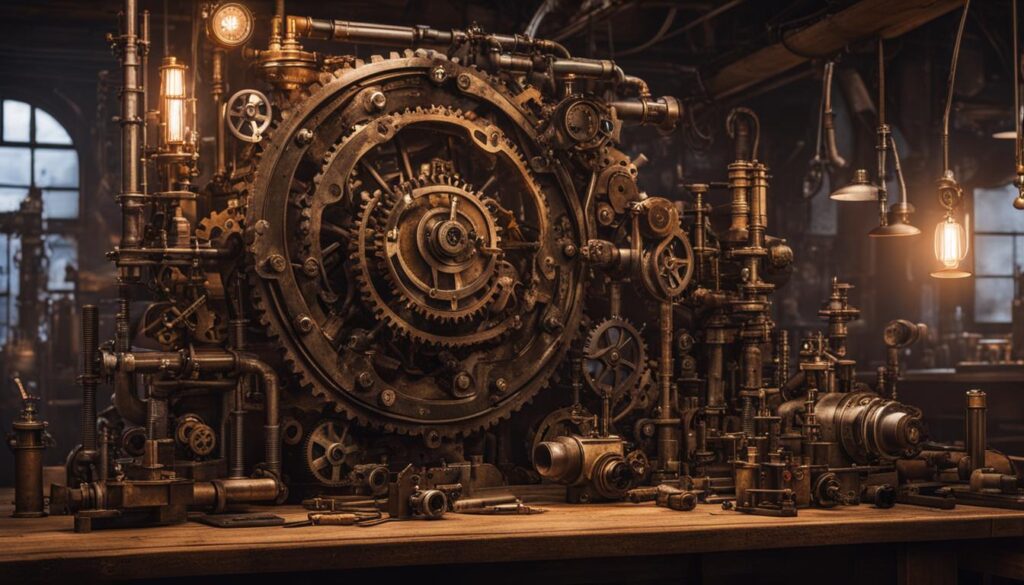
Quotes:
“Steampunk is all about reclaiming the spirit of invention and craftsmanship that once defined technology. It’s about bringing back the sense of individuality and artistry in a world dominated by mass production and homogeneity.” – Steampunk enthusiast
“Creating my own steampunk accessories allows me to infuse a part of myself into each piece. It’s a way of asserting my individuality and expressing my love for the beauty of mechanical craftsmanship.” – DIY steampunker
Table: Steampunk DIY vs. Modern Technology
| Steampunk DIY | Modern Technology |
|---|---|
| Emphasizes individuality | Focuses on mass production and standardization |
| Encourages creativity and problem-solving | Promotes passive consumption |
| Revives handmade craftsmanship | Relies on machine manufacturing |
| Reflects a sense of nostalgia | Represents progress and efficiency |
Through its emphasis on DIY and individuality, steampunk stands as a counterpoint to the homogenization of technology in our modern world. It encourages self-expression, creativity, and a return to the artistry and craftsmanship of the past. By reclaiming and repurposing objects, steampunks not only create unique accessories but also reclaim a sense of personal connection to technology. In a world where mass-produced, disposable gadgets dominate, steampunk serves as a reminder of the beauty and value of handmade, individualized creations.
Themes in Steampunk: Commodification, DIY, and Globalization
Steampunk delves into a multitude of themes that capture the essence of this imaginative subculture. Three prominent themes in steampunk are commodification, DIY (do-it-yourself) ethos, and globalization. These themes intertwine to shape the subculture’s identity and influence its growth and evolution.
Commodification is a prevalent theme in steampunk, referencing the commercialization and mass production of steampunk-inspired merchandise. While the availability of steampunk-themed clothing, accessories, and artwork has expanded the subculture’s reach, it has also raised concerns about diluting its original concept and motivations. However, steampunks continue to find ways to maintain authenticity and integrity through unique DIY creations and individual expressions of their style.
The DIY ethos is a fundamental aspect of the steampunk subculture. In a world dominated by mass-produced goods, steampunks embrace the craftsmanship and resourcefulness of the Victorian era. They take pride in creating their own accessories, modifying existing items, and repurposing materials, emphasizing personalization and uniqueness. The DIY spirit fosters a sense of community and encourages individuals to challenge the homogenization of technology.
Globalization plays a significant role in the dissemination and growth of the steampunk movement. The internet has facilitated connections among steampunk enthusiasts worldwide, enabling the exchange of ideas, inspiration, and cultural influences. Steampunk conventions and gatherings attract participants from various countries, contributing to the subculture’s global presence. This globalization has sparked cultural combinations and innovative interpretations of steampunk, further enriching the subculture’s diversity.
| Themes | Key Elements |
|---|---|
| Commodification | Commercialization of steampunk-inspired merchandise |
| DIY Ethos | Emphasis on personalization, craftsmanship, and resourcefulness |
| Globalization | Online connectivity, international conventions, and cultural exchanges |
“Steampunk’s themes of commodification, DIY, and globalization reflect its dynamic nature, as enthusiasts navigate the challenges of widespread commercialization while maintaining their commitment to personal expression and community-driven creativity.”
As steampunk continues to evolve and captivate a global audience, these themes remain central to its identity. Steampunks navigate the complexities of commodification, preserving their DIY ethos and cherishing the unique connections fostered by globalization. Together, these themes shape the multifaceted world of steampunk and inspire its participants to forge their own path in an alternate past filled with innovation, creativity, and imagination.
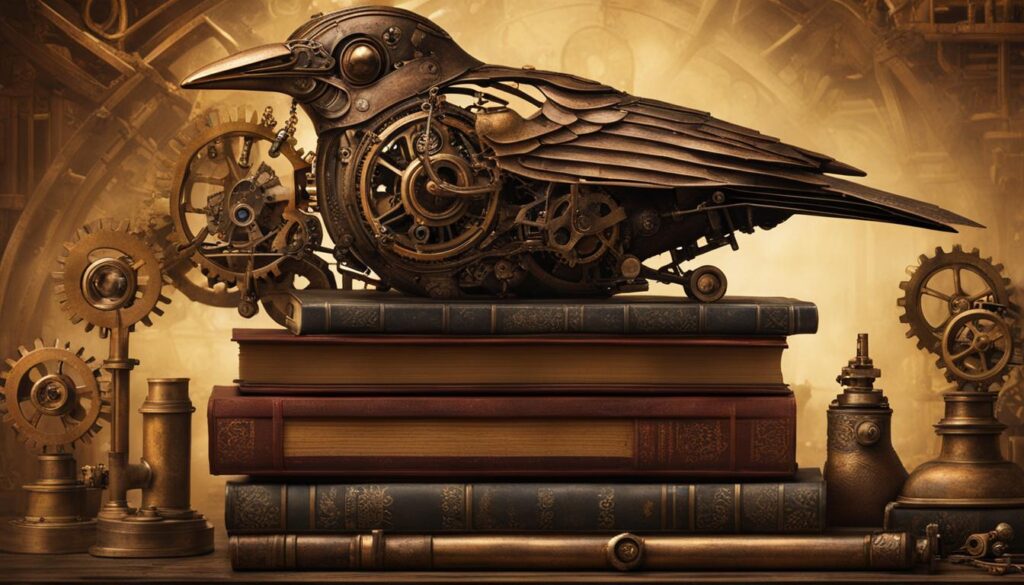
Table: Steampunk Bands
| Band | Genre | Key Instruments |
|---|---|---|
| The Cog is Dead | Steampunk Rock | Electric guitar, drums, accordion |
| Abney Park | Steampunk Industrial | Violin, synthesizers, brass instruments |
| Steam Powered Giraffe | Steampunk Vaudeville | Vocals, acoustic guitar, robot pantomime |
“Steampunk music is a seamless fusion of old-world charm and modern innovation. It combines the elegance of the Victorian era with the energy of contemporary music, creating a unique auditory experience.” – Steampunk enthusiast
Conclusion
Steampunk is not just a subculture; it’s a cultural movement that offers a unique and imaginative commentary on the consequences of the industrial revolution. By reimagining the history of the Victorian era and the Industrial Revolution, steampunk serves as a critique of the societal shifts caused by industrialization. It invites us to reflect on the impact of technology on our lives and the direction in which our world is headed.
Steampunk’s cultural significance lies in its celebration of the aesthetics and creativity of the Victorian era. Through its romanticized style and incorporation of open-faced clockwork machinery, steampunk pays homage to an era known for its elegance and innovation. It reminds us of the beauty that can be found in the mechanical and the handcrafted. By embracing the DIY ethos and rejecting the homogenization of technology, steampunk encourages individuality and self-expression.
At its core, steampunk provokes thought about our relationship with technology and the consequences of industrialization. It challenges us to consider the price we pay for progress and the potential ramifications on our society and environment. Steampunk’s alternative future, where steam remains the dominant source of power, prompts us to question the choices we have made and the path we are currently on.
Whether through literature, fashion, or music, steampunk has become a global phenomenon that continues to inspire and captivate a diverse range of participants. It provides a platform for united reflection on industrialization and its implications, while allowing for personal expression and creativity. Steampunk is more than just a subculture; it’s a doorway into a complex and thought-provoking world that invites us to question and reimagine our own reality.
FAQ
What is steampunk?
Steampunk is a subculture that reimagines the history of the Industrial Revolution during Victorian-era England, combining elements of the Victorian era, the Wild West, and steam-powered science fiction.
When did steampunk originate?
Steampunk originated in the 1900s as a subgenre of science fiction literature, focusing on clockwork mechanisms and nineteenth-century machinery and style.
What is the steampunk aesthetic and fashion?
The steampunk aesthetic is influenced by the Victorian era, combining sophisticated and elegant aesthetics with visible machinery known as open-faced clockwork. Steampunk fashion incorporates jewel tones, black, brown, and metallic elements like copper and brass.
What values does steampunk embrace?
Steampunk values the DIY ethos and craftsmanship of the Victorian era, emphasizing personalized and unique creations as a contrast to the uniformity of modern technology.
What are the main themes in steampunk?
Steampunk explores themes of commodification, DIY, and globalization. It critiques the commercialization of the subculture, promotes resourcefulness and originality in creation, and reflects on how technology has facilitated connections among participants around the world.
Does steampunk extend beyond fashion?
Yes, steampunk encompasses literature, music, and other forms of expression. It has developed subgenres in literature and has a presence in the music scene, with bands contributing to the cultural movement.
What is the significance of steampunk?
Steampunk serves as a cultural movement that offers a unique and imaginative commentary on the consequences of the industrial revolution. It critiques societal shifts while celebrating the aesthetics and creativity of the Victorian era.

